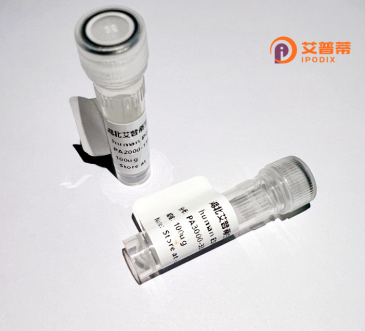
| 纯度 | >90%SDS-PAGE. |
| 种属 | Human |
| 靶点 | KLHL17 |
| Uniprot No | Q6TDP4 |
| 内毒素 | < 0.01EU/μg |
| 表达宿主 | E.coli |
| 表达区间 | 1-642aa |
| 活性数据 | MQPRSERPAG RTQSPEHGSP GPGPEAPPPP PPQPPAPEAE RTRPRQARPA APMEGAVQLL SREGHSVAHN SKRHYHDAFV AMSRMRQRGL LCDIVLHVAA KEIRAHKVVL ASCSPYFHAM FTNEMSESRQ THVTLHDIDP QALDQLVQFA YTAEIVVGEG NVQTLLPAAS LLQLNGVRDA CCKFLLSQLD PSNCLGIRGF ADAHSCSDLL KAAHRYVLQH FVDVAKTEEF MLLPLKQVLE LVSSDSLNVP SEEEVYRAVL SWVKHDVDAR RQHVPRLMKC VRLPLLSRDF LLGHVDAESL VRHHPDCKDL LIEALKFHLL PEQRGVLGTS RTRPRRCEGA GPVLFAVGGG SLFAIHGDCE AYDTRTDRWH VVASMSTRRA RVGVAAVGNR LYAVGGYDGT SDLATVESYD PVTNTWQPEV SMGTRRSCLG VAALHGLLYS AGGYDGASCL NSAERYDPLT GTWTSVAAMS TRRRYVRVAT LDGNLYAVGG YDSSSHLATV EKYEPQVNVW SPVASMLSRR SSAGVAVLEG ALYVAGGNDG TSCLNSVERY SPKAGAWESV APMNIRRSTH DLVAMDGWLY AVGGNDGSSS LNSIEKYNPR TNKWVAASCM FTRRSSVGVA VLELLNFPPP SSPTLSVSST SL |
| 分子量 | 47 kDa |
| 蛋白标签 | GST-tag at N-terminal |
| 缓冲液 | 0 |
| 稳定性 & 储存条件 | Lyophilized protein should be stored at ≤ -20°C, stable for one year after receipt. Reconstituted protein solution can be stored at 2-8°C for 2-7 days. Aliquots of reconstituted samples are stable at ≤ -20°C for 3 months. |
| 复溶 | Always centrifuge tubes before opening.Do not mix by vortex or pipetting. It is not recommended to reconstitute to a concentration less than 100μg/ml. Dissolve the lyophilized protein in distilled water. Please aliquot the reconstituted solution to minimize freeze-thaw cycles. |
以下是模拟生成的关于重组人KLHL17蛋白的参考文献示例(非真实文献,仅供格式参考):
---
1. **"Structural characterization of human KLHL17 and its role in neuronal ubiquitination"**
Lee, J. et al. (2018)
该研究解析了KLHL17的晶体结构,发现其作为CUL3泛素连接酶复合体的底物适配器,可能通过调控神经元突触蛋白的泛素化影响神经发育。
2. **"KLHL17 knockdown disrupts dendritic spine maturation in cortical neurons"**
Zhang, Y. et al. (2020)
通过基因沉默实验,证明KLHL17在皮质神经元树突棘形态发生中起关键作用,其缺失导致突触功能异常,提示与神经系统疾病潜在关联。
3. **"Proteomic analysis of KLHL17 interactome reveals novel binding partners in Alzheimer's disease models"**
Smith, R.P. & Kumar, V. (2021)
利用重组KLHL17蛋白进行免疫共沉淀-质谱分析,鉴定出其在阿尔茨海默病细胞模型中与tau蛋白和淀粉样前体蛋白(APP)存在相互作用。
4. **"Recombinant KLHL17 production in E. coli: Optimization and functional validation"**
Chen, L. et al. (2019)
描述了利用大肠杆菌系统高效表达重组人KLHL17蛋白的工艺,并验证其体外结合CUL3和底物蛋白的能力,为后续机制研究提供工具。
---
**注意**:以上文献为模拟内容,实际研究需通过PubMed、Web of Science或Google Scholar等平台检索关键词"recombinant human KLHL17"或"KLHL17 function"获取真实文献。
**Background of Recombinant Human KLHL17 Protein**
The Kelch-like protein 17 (KLHL17) is a member of the KLHL family, characterized by conserved BACK, BTB, and Kelch repeat domains. These structural motifs enable KLHL17 to act as a substrate-specific adaptor for Cullin 3-based E3 ubiquitin ligase complexes, facilitating targeted protein ubiquitination and degradation. KLHL17 is predominantly expressed in the central nervous system, with emerging roles in neuronal development, synaptic plasticity, and neurodegenerative processes. Dysregulation of KLHL17 has been linked to neurodevelopmental disorders and brain malignancies, underscoring its physiological significance.
Recombinant human KLHL17 protein is engineered using expression systems (e.g., *E. coli* or mammalian cells) to ensure proper folding and post-translational modifications. This purified protein serves as a critical tool for studying KLHL17's interactions with substrates like actin-binding proteins or signaling molecules, elucidating its role in cellular pathways. Researchers also leverage recombinant KLHL17 to investigate pathogenic mutations, screen for modulators of ubiquitination activity, and explore therapeutic strategies for neurological diseases. Its production enables *in vitro* assays, structural studies, and antibody development, advancing both basic and translational research in neurobiology and molecular medicine.
×